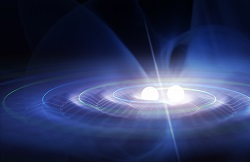A holographic description of gravity
When she started her work in 2015, Dr Manuela Kulaxizi, postdoc fellow at Trinity College Dublin’s School of Mathematics, aimed to investigate and highlight quantum aspects of the AdS/CFT correspondence such as the emergence of space-time and gravity, all in a controlled set-up. She did so by studying entanglement and CFT correlation functions at large N. Whilst highly theoretical, such studies actually set the stage for future black hole studies: ‘Based on current ideas about string theory and gravity, we expect that the quantum theory of gravity should be “holographic”,’ Dr Kulaxizi says. ‘This means that there should exist a description of the physics of gravity based on a completely different quantum theory, similar to the one that describes the binding of the constituent quarks and gluons into the nuclei of the atoms – but with one less dimension. This is the holographic description of gravity, which my research contributes to.’ The project’s strategy consisted in considering a Conformal Field Theory (CFT) – an ordinary quantum theory endowed with conformal invariance – and investigating the conditions under which such a theory has an alternative description in terms of gravity. ‘The additional amount of symmetry makes the theory way more tractable than ordinary quantum field theories,’ Dr Kulaxizi explains. The team focused on a special class of CFTs which are likely to have a gravitational description, with a view to computing certain four-point correlation functions in those CFTs. CFT correlation functions were expected to provide the dual/holographic description of ‘scattering of particles in gravity’. Thanks to a simplified calculation focusing on a special limit corresponding to the scattering of very fast-moving particles, along with the imposition of unitarity on the result for their correlation function, the team were able to make gravity emerge from their calculations. Dr Kulaxizi explains the experimental setup: ‘Einstein’s theory of gravity predicts that to some approximation, when two very fast particles collide with each other, they continue their way almost undisturbed except for one effect: they experience a time-delay. Our work described how to obtain the exact same expression for the time-delay, the same physics, in terms of a completely different quantity which is naturally defined in the alternative holographic description of gravity.’ Fast travelling particles have an interesting effect on the space surrounding them: they produce a non-trivial curvature around them called ‘shock-wave geometry’. The project’s results shed light on how the description of the spacetime formed around a very fast travelling object can be obtained, using notions and quantities naturally defined in the holographic description of gravity. In particular, the metric function of the shock-wave geometry was identified with the stress-tensor conformal block in a special limit (the Regge limit). ‘More importantly, we were able to explicitly show that a certain class of ordinary quantum field theories – conformal field theories – have an equivalent description in terms of a specific theory of gravity: Einstein’s gravity theory. For instance, we showed that under certain assumptions, the theory contains particles of maximum spin equal to two, with properties matching those of the graviton. We also showed that other theories of gravity, e.g. Lanczos-Gauss-Bonnet gravity, cannot arise from a consistent CFT,’ Dr Kulaxizi says. Dr Kulaxizi hopes that this work will be just the first in a longer series of efforts that will help unveil some of the mysteries behind quantum gravity and black hole physics.
Keywords
QEAH, holography, relativity, quantum physics, AdS/CFT, conformal field theory, CFT, black hole, gravity

